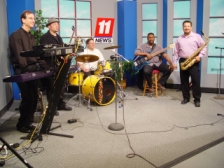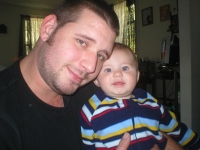Friday, December 11, 2009
All About Major Scales 1
Major Scales Piano Lesson 1
In music, there is a pattern for everything! I’m going to teach you the pattern used to create major scales.
First, let’s start with the basics. There are 12 major scales; one for every major key on the piano
You have the white keys:
C major
D major
E major
F major
G major
A major
B major
… and then you have the black keys (called “sharps” or “flats”):
C Sharp or D flat
D Sharp or E flat
F Sharp or G flat
G Sharp or A flat
A Sharp or B flat
Today, we will learn how to form the following major scales:
(1) C Major Scale
(2) D Major Scale
(3) E Major Scale
(4) F Major Scale
(5) G Major Scale
(6) A Major Scale
In order to form major scales, you have to understand the concept of “whole steps and half steps.”
… here's a quick mini lesson on whole steps and half steps:
Whole steps and half steps describe distance in music. That is, the distance in notes from one key to another.
————-
Whole Step
————-
A “whole” step always skips a key…
————-
Half Step
————-
A “half” step never skips a key…
Remember this poem:
“A half step is from KEY TO KEY with NO keys in between, A whole step always SKIPS a key with one key in between”
EXAMPLES:
“D” is 1 whole step higher than “C”
Why? Because if you start at C and “skip” a key, you’ll arrive at “D”. What key are you skipping? Let’s see:
C — (skip C#) — D
However, “C#” is 1 half step higher than “C”
Why? Because you are NOT skipping any keys to go from “C” to “C#.”
So essentially:
1 Whole Step = 2 keys
1 Half Step = 1 key
More examples:
C to D = 1 whole step
C to E = 2 whole steps
… and so on.
(Whole Step = “w” *** Half Step = “h”)
The Major Scale pattern is as follow:
w - w - h - w - w - w - h
This means:
1. From the starting note, the second note will be 1 (w)hole step higher.
2. From the second note, the third note will be another whole step higher.
3. From the third note, the fourth note will be a (h)alf step higher.
4. From the fourth note, the fifth note will be a whole step higher.
5. From the fifth tone, the sixth note will be a whole step higher.
6. From the sixth tone, the seventh tone will also be a whole step higher.
7. From the seventh tone, the last tone will be only a half step higher.
In C major:
1. The starting note is “C”
2. 1 whole step up is “D” (w)
3. Another whole step up is “E” (w)
4. 1 half step up is “F” (h)
5. 1 whole step up is “G” (w)
6. Another whole step up is “A” (w)
7. Another whole step up is “B” (w)
8. 1 half step up is “C” (h)
Exercise:
Repeat these 8 steps with the following major scales. The answers are listed below:
2) D major
3) E major
4) F major
5) G major
6) A major
————————–
D major:
1) Starting note = ______
2) 1 whole step up = ______
3) 1 whole step up = ______
4) 1 half step up = _____
5) 1 whole step up = ______
6) 1 whole step up = ______
7) 1 whole step up = ______
8) 1 half step up = ______
E major:
1) Starting note = ______
2) 1 whole step up = ______
3) 1 whole step up = ______
4) 1 half step up = _____
5) 1 whole step up = ______
6) 1 whole step up = ______
7) 1 whole step up = ______
8) 1 half step up = ______
F major:
1) Starting note = ______
2) 1 whole step up = ______
3) 1 whole step up = ______
4) 1 half step up = _____
5) 1 whole step up = ______
6) 1 whole step up = ______
7) 1 whole step up = ______
8) 1 half step up = ______
G major:
1) Starting note = ______
2) 1 whole step up = ______
3) 1 whole step up = ______
4) 1 half step up = _____
5) 1 whole step up = ______
6) 1 whole step up = ______
7) 1 whole step up = ______
8) 1 half step up = ______
A major:
1) Starting note = ______
2) 1 whole step up = ______
3) 1 whole step up = ______
4) 1 half step up = _____
5) 1 whole step up = ______
6) 1 whole step up = ______
7) 1 whole step up = ______
8) 1 half step up = ______
———————————-
Note: Remember, in major scales, each note is played separately. Only in chords are more than 2 notes played at the same time.
Scales = play each note separately
Chords = play all notes together
Here are the answers:
D major
D - E - F# - G - A - B - C# - D
E major
E - F# - G# - A - B - C# - D# - E
F major
F - G - A - Bb - C - D - E - F
G major
G - A - B - C - D - E - F# - G
A major
A - B - C# - D - E - F# - G# - A
——————–
If you thought this little lesson was informative, imagine what you will learn in Jermaine Griggs' 300-pg piano course? For more information, visit:
http://www.hearandplay.com/478543/course
Thank you for reading!
In music, there is a pattern for everything! I’m going to teach you the pattern used to create major scales.
First, let’s start with the basics. There are 12 major scales; one for every major key on the piano
You have the white keys:
C major
D major
E major
F major
G major
A major
B major
… and then you have the black keys (called “sharps” or “flats”):
C Sharp or D flat
D Sharp or E flat
F Sharp or G flat
G Sharp or A flat
A Sharp or B flat
Today, we will learn how to form the following major scales:
(1) C Major Scale
(2) D Major Scale
(3) E Major Scale
(4) F Major Scale
(5) G Major Scale
(6) A Major Scale
In order to form major scales, you have to understand the concept of “whole steps and half steps.”
… here's a quick mini lesson on whole steps and half steps:
Whole steps and half steps describe distance in music. That is, the distance in notes from one key to another.
————-
Whole Step
————-
A “whole” step always skips a key…
————-
Half Step
————-
A “half” step never skips a key…
Remember this poem:
“A half step is from KEY TO KEY with NO keys in between, A whole step always SKIPS a key with one key in between”
EXAMPLES:
“D” is 1 whole step higher than “C”
Why? Because if you start at C and “skip” a key, you’ll arrive at “D”. What key are you skipping? Let’s see:
C — (skip C#) — D
However, “C#” is 1 half step higher than “C”
Why? Because you are NOT skipping any keys to go from “C” to “C#.”
So essentially:
1 Whole Step = 2 keys
1 Half Step = 1 key
More examples:
C to D = 1 whole step
C to E = 2 whole steps
… and so on.
(Whole Step = “w” *** Half Step = “h”)
The Major Scale pattern is as follow:
w - w - h - w - w - w - h
This means:
1. From the starting note, the second note will be 1 (w)hole step higher.
2. From the second note, the third note will be another whole step higher.
3. From the third note, the fourth note will be a (h)alf step higher.
4. From the fourth note, the fifth note will be a whole step higher.
5. From the fifth tone, the sixth note will be a whole step higher.
6. From the sixth tone, the seventh tone will also be a whole step higher.
7. From the seventh tone, the last tone will be only a half step higher.
In C major:
1. The starting note is “C”
2. 1 whole step up is “D” (w)
3. Another whole step up is “E” (w)
4. 1 half step up is “F” (h)
5. 1 whole step up is “G” (w)
6. Another whole step up is “A” (w)
7. Another whole step up is “B” (w)
8. 1 half step up is “C” (h)
Exercise:
Repeat these 8 steps with the following major scales. The answers are listed below:
2) D major
3) E major
4) F major
5) G major
6) A major
————————–
D major:
1) Starting note = ______
2) 1 whole step up = ______
3) 1 whole step up = ______
4) 1 half step up = _____
5) 1 whole step up = ______
6) 1 whole step up = ______
7) 1 whole step up = ______
8) 1 half step up = ______
E major:
1) Starting note = ______
2) 1 whole step up = ______
3) 1 whole step up = ______
4) 1 half step up = _____
5) 1 whole step up = ______
6) 1 whole step up = ______
7) 1 whole step up = ______
8) 1 half step up = ______
F major:
1) Starting note = ______
2) 1 whole step up = ______
3) 1 whole step up = ______
4) 1 half step up = _____
5) 1 whole step up = ______
6) 1 whole step up = ______
7) 1 whole step up = ______
8) 1 half step up = ______
G major:
1) Starting note = ______
2) 1 whole step up = ______
3) 1 whole step up = ______
4) 1 half step up = _____
5) 1 whole step up = ______
6) 1 whole step up = ______
7) 1 whole step up = ______
8) 1 half step up = ______
A major:
1) Starting note = ______
2) 1 whole step up = ______
3) 1 whole step up = ______
4) 1 half step up = _____
5) 1 whole step up = ______
6) 1 whole step up = ______
7) 1 whole step up = ______
8) 1 half step up = ______
———————————-
Note: Remember, in major scales, each note is played separately. Only in chords are more than 2 notes played at the same time.
Scales = play each note separately
Chords = play all notes together
Here are the answers:
D major
D - E - F# - G - A - B - C# - D
E major
E - F# - G# - A - B - C# - D# - E
F major
F - G - A - Bb - C - D - E - F
G major
G - A - B - C - D - E - F# - G
A major
A - B - C# - D - E - F# - G# - A
——————–
If you thought this little lesson was informative, imagine what you will learn in Jermaine Griggs' 300-pg piano course? For more information, visit:
http://www.hearandplay.com/478543/course
Thank you for reading!
Tuesday, May 12, 2009
Organ Worship Basics & Chords (A lot Of Free Chord Progressions)
Over 20 minutes of Free Organ Video Lessons Available Here
The organ is a lot different from the piano, although the concept of progressions and how chord changes work generally remain the same.
Basically, a "2-5-1" progression on the piano is still a "2-5-1" progression on the organ. For example, in the key of C major, the progression would still consist of some kind of D chord (almost always minor) going to a G chord, finally ending at a C chord. While this doesn't change on the organ, how you play each particular chord will differ from the piano.
I would argue that if you understand the way music works... how scales create chords >>> chords create progressions >>> progressions create songs --- then you already have a head-start when it comes to picking up a new instrument (...even guitar).
Don't get me wrong... there are some differences:
One major difference between the piano/keyboard and organ is what I call the "third element." You're now managing a foot pedal along with both your left and right hands.
Right off the bat, it requires more coordination. Then... there's the "don't lift your fingers" rule and the "slide" technique to make your chords sound smooth. Of course, you have to know how to operate the organ (the drawbars, settings, switches, percussions, etc.).
With all of this aside, what it all amounts to is the foot and left hand, in my opinion.
In gospel music, most of us are familiar with playing chords on the right hand. If you play with a band, then you're probably already accustomed to splitting up your chords into two hands with both your left and right hands constantly at work.
If you're solo, then you've probably grown to play bass patterns (or power chords) on your left with full chords on your right.
The organ changes all of this because it gives you a "bass player" (so to speak) --- YOUR FOOT!
The good thing about this is that it frees your left hand up to do many things.
==> For example, you can play chords on your left and solo with scales, modes, and "licks" on your right hand.
==> You can play a huge chord by starting it on your left and ending it on your right.
==> You can take what you are playing on your right hand and play a variation of it on the left hand making your chord sound full!
==> You can play the same "lick" on your left and right hands while walking the bass on your foot.
... and the list goes on.
So on that note, I want to give you some of the same chord progressions you'll be learning in GospelKeys 450 - Worship Chords & Voicings!" I warn you... the chords taught in 450 aren't for the pure beginner.
Example Chord Progression #1
First, I'll give you a 2-5-1 progression.
"2-5-1" progressions are very popular and commonly used to end a song or to wrap a verse back around to the beginning.
They are called 2-5-1's because each number represents a tone of the major scale you're playing in.
C major:
C D E F G A B C
C=1
D=2
E=3
F=4
G=5
A=6
B=7
C = 8 (or basically "1" again).
In the key of C major, the 2nd degree of the scale is D. Likewise, the 5th degree is G and if you're catching on, the 1st degree is C itself.
So basically any chord based on D (usually minor) going to any 5... then back home to the 1st tone would constitute a "2-5-1" progression.
On the organ, this is no different.
Since there are 12 major scales, there are 12 major keys a chord progression could possibly be in.
In GospelKeys 450, we're in the key of Db major.
Therefore, our numbers would come from the Db major scale:
Db Eb F Gb Ab Bb C Db
Db = 1
Eb = 2
F = 3
Gb = 4
Ab = 5
Bb = 6
C = 7
Db = 8 (or basically "1" again).
Now for the chord progression:
Ebmin11 (pronounced "E flat minor eleventh")
Left hand: Db F Ab Bb
Right hand: Db F Ab
Bass pedal: Eb
Ab13 (b9)
Left hand: C Gb
Right hand: C F A C
Bass pedal: Ab
Db 9/6
Left hand: F Bb
Right hand: Eb Ab Db
Bass pedal: Db
Example Chord Progression #2
This next set of chords is also a "2-5-1" chord progression.
Ebmin11 (voiced differently)
Left hand: Gb Ab Bb
Right hand: Db F Ab
Bass pedal: Eb
Ab13 (b9)
Left hand: Eb Gb A C
Right hand: F A C
Bass pedal: Ab
Db 9/6
Left hand: F Ab Bb C
Right hand: Eb Ab C
Bass pedal: Db
Example Chord Progression #3
Now, we'll change things up a little bit and learn examples of the "7-3-6" progression. In GospelKeys 450, you'll learn how to apply these progressions in real-life songs. For now, I'll introduce them just so that you can get an idea of how chords are voiced on the organ.
Similar to the 2-5-1 progression, the numbers come from the major scale that you're playing in.
In our case, it's Db major:
Db Eb F Gb Ab Bb C Db
Db = 1
Eb = 2
F = 3
Gb = 4
Ab = 5
Bb = 6
C = 7
Db = 8 (or basically "1" again).
So in the key of Db major, a 7-3-6 progression would be some kind of C chord going to an F chord... then resting on a Bb chord. Let's check out an example:
C7 (#9#5)
Left hand: E Bb
Right hand: Eb Ab C
Bass pedal: C
F7 (#9#5)
Left hand: Eb A Db
Right hand: F Ab Db
Bass pedal: F
Bbmin9
Left hand: Db F Ab C
Right hand: Eb Ab C
Bass pedal: Bb
Example Chord Progression #4
Here's another version of the 7-3-6 progression:
C7 (#9b5)
Left hand: C E
Right hand: Bb Eb Gb
Bass pedal: C
F13Left hand: Eb G
Right hand: Bb D F
Bass pedal: F
Bbmaj9 (add 6)Left hand: D F G
Right hand: A C D F
Bass pedal: Bb
Example Chord Progression #5
My last example has the same purpose as the previous two progressions (...that is, to get you to the 6th degree of the scale). However, instead of using conventional ways to get there like the 7-3-6, it uses the #4 and #5 ("sharped fourth and sharped fifth") to get to the 6th degree.
Bass pattern: G >>> A >>> Bb
G7 / 6 (#5)
Left hand: F B Eb
Right hand: F B E
Bass pedal: G
Amin7 (#5)
Left hand: G C F
Right hand: G C F
Bass pedal: A
Bbmin11Left hand: Ab C Db F
Right hand: Ab C Eb
Bass pedal: Bb
If you were intrigued by the lesson above, I invite you to click here for more information on GospelKeys 350 and GospelKeys 450.
Over 20 minutes of Free Organ Video Lessons available here
Thanks for reading,
Lucion Pennant
The organ is a lot different from the piano, although the concept of progressions and how chord changes work generally remain the same.
Basically, a "2-5-1" progression on the piano is still a "2-5-1" progression on the organ. For example, in the key of C major, the progression would still consist of some kind of D chord (almost always minor) going to a G chord, finally ending at a C chord. While this doesn't change on the organ, how you play each particular chord will differ from the piano.
I would argue that if you understand the way music works... how scales create chords >>> chords create progressions >>> progressions create songs --- then you already have a head-start when it comes to picking up a new instrument (...even guitar).
Don't get me wrong... there are some differences:
One major difference between the piano/keyboard and organ is what I call the "third element." You're now managing a foot pedal along with both your left and right hands.
Right off the bat, it requires more coordination. Then... there's the "don't lift your fingers" rule and the "slide" technique to make your chords sound smooth. Of course, you have to know how to operate the organ (the drawbars, settings, switches, percussions, etc.).
With all of this aside, what it all amounts to is the foot and left hand, in my opinion.
In gospel music, most of us are familiar with playing chords on the right hand. If you play with a band, then you're probably already accustomed to splitting up your chords into two hands with both your left and right hands constantly at work.
If you're solo, then you've probably grown to play bass patterns (or power chords) on your left with full chords on your right.
The organ changes all of this because it gives you a "bass player" (so to speak) --- YOUR FOOT!
The good thing about this is that it frees your left hand up to do many things.
==> For example, you can play chords on your left and solo with scales, modes, and "licks" on your right hand.
==> You can play a huge chord by starting it on your left and ending it on your right.
==> You can take what you are playing on your right hand and play a variation of it on the left hand making your chord sound full!
==> You can play the same "lick" on your left and right hands while walking the bass on your foot.
... and the list goes on.
So on that note, I want to give you some of the same chord progressions you'll be learning in GospelKeys 450 - Worship Chords & Voicings!" I warn you... the chords taught in 450 aren't for the pure beginner.
Example Chord Progression #1
First, I'll give you a 2-5-1 progression.
"2-5-1" progressions are very popular and commonly used to end a song or to wrap a verse back around to the beginning.
They are called 2-5-1's because each number represents a tone of the major scale you're playing in.
C major:
C D E F G A B C
C=1
D=2
E=3
F=4
G=5
A=6
B=7
C = 8 (or basically "1" again).
In the key of C major, the 2nd degree of the scale is D. Likewise, the 5th degree is G and if you're catching on, the 1st degree is C itself.
So basically any chord based on D (usually minor) going to any 5... then back home to the 1st tone would constitute a "2-5-1" progression.
On the organ, this is no different.
Since there are 12 major scales, there are 12 major keys a chord progression could possibly be in.
In GospelKeys 450, we're in the key of Db major.
Therefore, our numbers would come from the Db major scale:
Db Eb F Gb Ab Bb C Db
Db = 1
Eb = 2
F = 3
Gb = 4
Ab = 5
Bb = 6
C = 7
Db = 8 (or basically "1" again).
Now for the chord progression:
Ebmin11 (pronounced "E flat minor eleventh")
Left hand: Db F Ab Bb
Right hand: Db F Ab
Bass pedal: Eb
Ab13 (b9)
Left hand: C Gb
Right hand: C F A C
Bass pedal: Ab
Db 9/6
Left hand: F Bb
Right hand: Eb Ab Db
Bass pedal: Db
Example Chord Progression #2
This next set of chords is also a "2-5-1" chord progression.
Ebmin11 (voiced differently)
Left hand: Gb Ab Bb
Right hand: Db F Ab
Bass pedal: Eb
Ab13 (b9)
Left hand: Eb Gb A C
Right hand: F A C
Bass pedal: Ab
Db 9/6
Left hand: F Ab Bb C
Right hand: Eb Ab C
Bass pedal: Db
Example Chord Progression #3
Now, we'll change things up a little bit and learn examples of the "7-3-6" progression. In GospelKeys 450, you'll learn how to apply these progressions in real-life songs. For now, I'll introduce them just so that you can get an idea of how chords are voiced on the organ.
Similar to the 2-5-1 progression, the numbers come from the major scale that you're playing in.
In our case, it's Db major:
Db Eb F Gb Ab Bb C Db
Db = 1
Eb = 2
F = 3
Gb = 4
Ab = 5
Bb = 6
C = 7
Db = 8 (or basically "1" again).
So in the key of Db major, a 7-3-6 progression would be some kind of C chord going to an F chord... then resting on a Bb chord. Let's check out an example:
C7 (#9#5)
Left hand: E Bb
Right hand: Eb Ab C
Bass pedal: C
F7 (#9#5)
Left hand: Eb A Db
Right hand: F Ab Db
Bass pedal: F
Bbmin9
Left hand: Db F Ab C
Right hand: Eb Ab C
Bass pedal: Bb
Example Chord Progression #4
Here's another version of the 7-3-6 progression:
C7 (#9b5)
Left hand: C E
Right hand: Bb Eb Gb
Bass pedal: C
F13Left hand: Eb G
Right hand: Bb D F
Bass pedal: F
Bbmaj9 (add 6)Left hand: D F G
Right hand: A C D F
Bass pedal: Bb
Example Chord Progression #5
My last example has the same purpose as the previous two progressions (...that is, to get you to the 6th degree of the scale). However, instead of using conventional ways to get there like the 7-3-6, it uses the #4 and #5 ("sharped fourth and sharped fifth") to get to the 6th degree.
Bass pattern: G >>> A >>> Bb
G7 / 6 (#5)
Left hand: F B Eb
Right hand: F B E
Bass pedal: G
Amin7 (#5)
Left hand: G C F
Right hand: G C F
Bass pedal: A
Bbmin11Left hand: Ab C Db F
Right hand: Ab C Eb
Bass pedal: Bb
If you were intrigued by the lesson above, I invite you to click here for more information on GospelKeys 350 and GospelKeys 450.
Over 20 minutes of Free Organ Video Lessons available here
Thanks for reading,
Lucion Pennant
Labels:
Free Lesson
Wednesday, April 15, 2009
Learn The Secrets To Playing All Your Favorite Slow Worship Songs By Ear, Guaranteed!
 Learn how to play all of your favorite slow worship songs by ear with Gospelkeys 202 Special Edition. Learn chord progressions, licks, tricks and much, much more. Click here to learn more.
Learn how to play all of your favorite slow worship songs by ear with Gospelkeys 202 Special Edition. Learn chord progressions, licks, tricks and much, much more. Click here to learn more.These are some examples of the kind of stuff you will learn, are you ready?
Buckle up and check out these videos...
Click here for more free videos!
Subscribe to:
Posts (Atom)





















 I
have been playing the piano for 10 years and I've never been able to
place at the level I should be until I ran across Jermaine's Hear and
Play website. After I ordered my first set of DVD's,
I
have been playing the piano for 10 years and I've never been able to
place at the level I should be until I ran across Jermaine's Hear and
Play website. After I ordered my first set of DVD's,
 Smooth Jazz band at local TV station." border="0" height="168" align="left" width="224">
Smooth Jazz band at local TV station." border="0" height="168" align="left" width="224"> me and lil dude" align="left" border="0" height="150" width="200">
me and lil dude" align="left" border="0" height="150" width="200">
